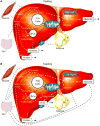The liver
- PMID: 29112863
- PMCID: PMC5897118
- DOI: 10.1016/j.cub.2017.09.019
The liver
Abstract
The liver is a critical hub for numerous physiological processes. These include macronutrient metabolism, blood volume regulation, immune system support, endocrine control of growth signaling pathways, lipid and cholesterol homeostasis, and the breakdown of xenobiotic compounds, including many current drugs. Processing, partitioning, and metabolism of macronutrients provide the energy needed to drive the aforementioned processes and are therefore among the liver's most critical functions. Moreover, the liver's capacities to store glucose in the form of glycogen, with feeding, and assemble glucose via the gluconeogenic pathway, in response to fasting, are critical. The liver oxidizes lipids, but can also package excess lipid for secretion to and storage in other tissues, such as adipose. Finally, the liver is a major handler of protein and amino acid metabolism as it is responsible for the majority of proteins secreted in the blood (whether based on mass or range of unique proteins), the processing of amino acids for energy, and disposal of nitrogenous waste from protein degradation in the form of urea metabolism. Over the course of evolution this array of hepatic functions has been consolidated in a single organ, the liver, which is conserved in all vertebrates. Developmentally, this organ arises as a result of a complex differentiation program that is initiated by exogenous signal gradients, cellular localization cues, and an intricate hierarchy of transcription factors. These processes that are fully developed in the mature liver are imperative for life. Liver failure from any number of sources (e.g. viral infection, overnutrition, or oncologic burden) is a global health problem. The goal of this primer is to concisely summarize hepatic functions with respect to macronutrient metabolism. Introducing concepts critical to liver development, organization, and physiology sets the stage for these functions and serves to orient the reader. It is important to emphasize that insight into hepatic pathologies and potential therapeutic avenues to treat these conditions requires an understanding of the development and physiology of specialized hepatic functions.
Copyright © 2017 Elsevier Ltd. All rights reserved.
Figures


References
-
- Bechmann LP, Hannivoort RA, Gerken G, Hotamisligil GS, Trauner M, Canbay A. The interaction of hepatic lipid and glucose metabolism in liver diseases. J Hepatol. 2012;56:952–964. - PubMed
-
- Hijmans BS, Grefhorst A, Oosterveer MH, Groen AK. Zonation of glucose and fatty acid metabolism in the liver: mechanism and metabolic consequences. Biochimie. 2014;96:121–129. - PubMed
MeSH terms
Substances
Grants and funding
LinkOut - more resources
Full Text Sources
Other Literature Sources

